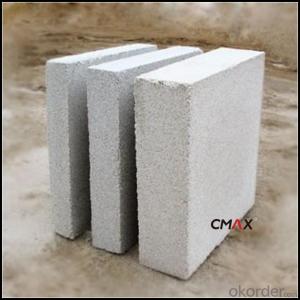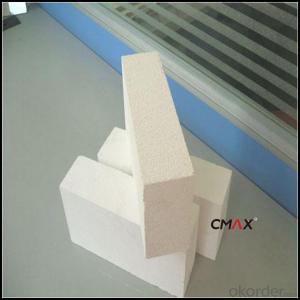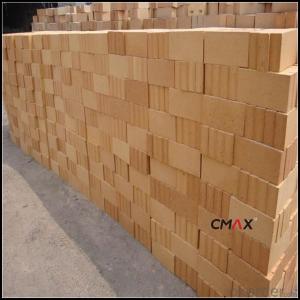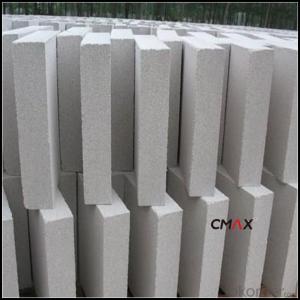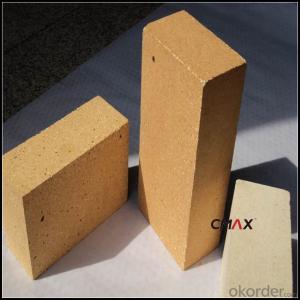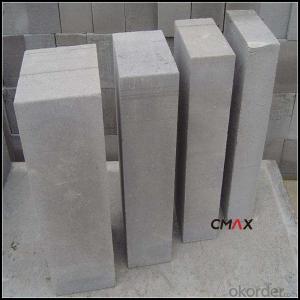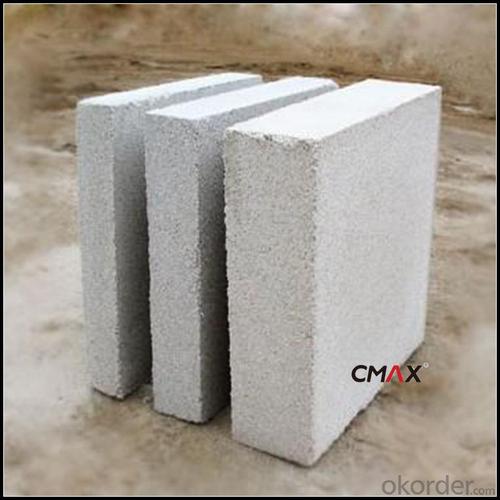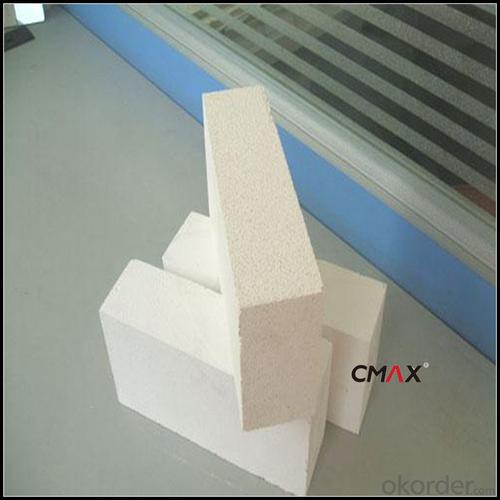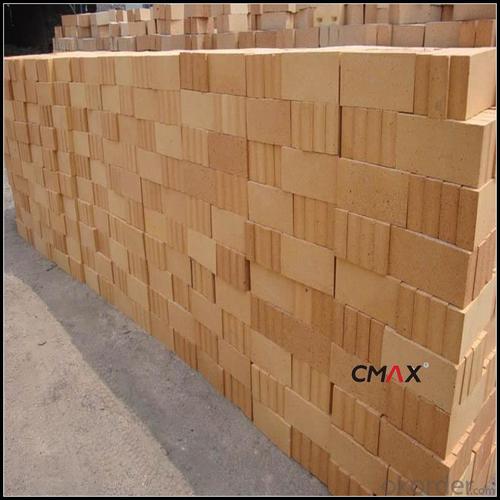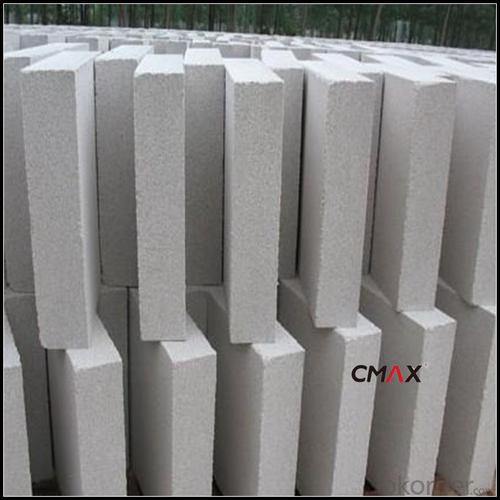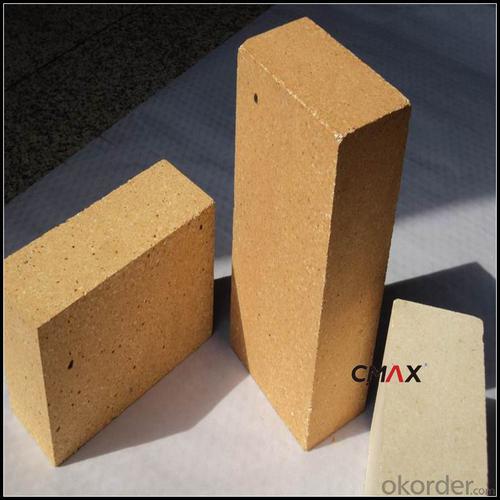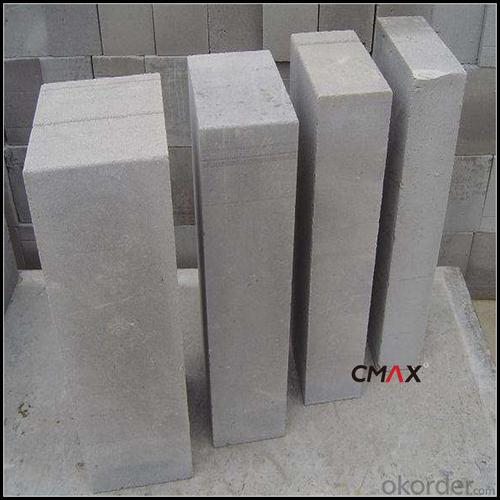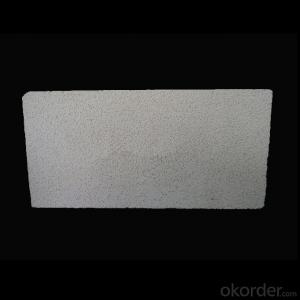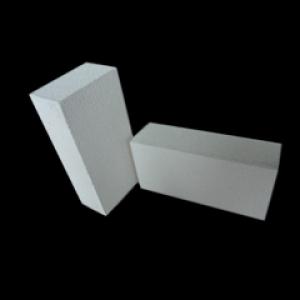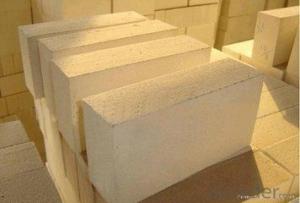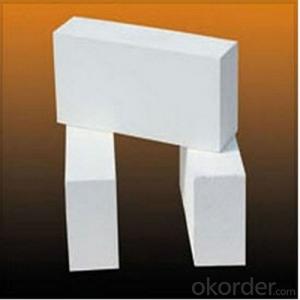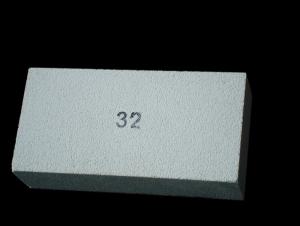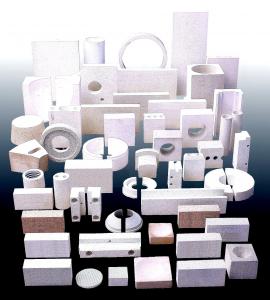High Temperature Insulating Fire Brick
- Loading Port:
- China main port
- Payment Terms:
- TT OR LC
- Min Order Qty:
- 2 m.t
- Supply Capability:
- 2000 m.t/month
OKorder Service Pledge
OKorder Financial Service
You Might Also Like
Insulating Brick
CMAX insulating firebricks are classified under temperature between 1300℃ to 1700℃, manufactured from high purity alumina clay.
High strength clay heat insulation refractory brick use high quality hollow drift beads and super clay as the main raw material, through high heat sintering. With the characteristics of high strength, low thermal conductivity, is suitable for industry kiln under 1350 ℃ heat insulation layer and the lining.
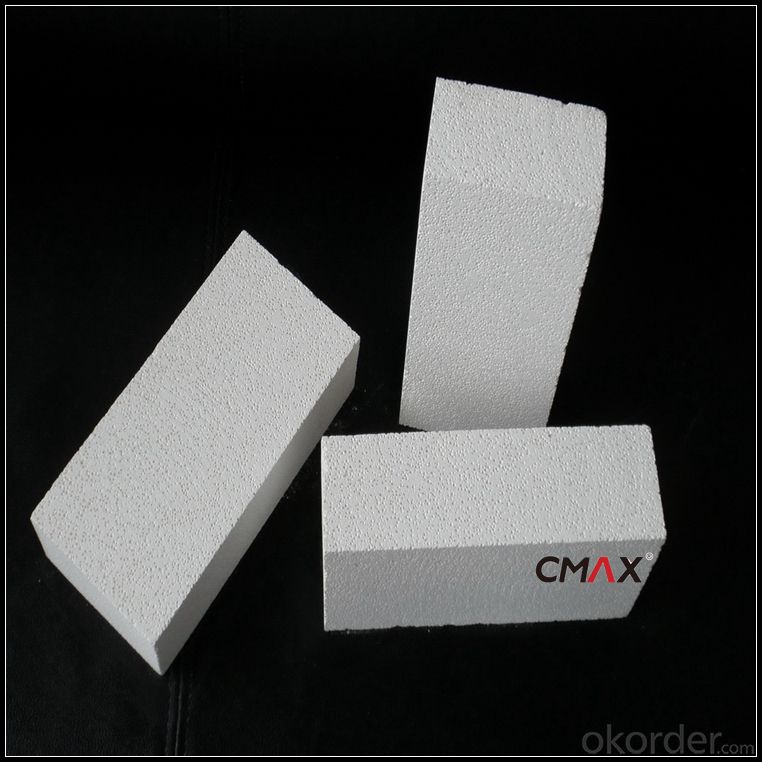
Insulating Brick Features
1)Excellent wear resistance
2)Good impact resistance.
3)Good corrosion resistantce.
4)Good adherence
Insulating Brick Application
1)Excellent wear resistance and long working life.
2)Good impact resistance.
3)Good corrosion resistance.
4)Good thermal shock resistance
5)High wear resistantance
6)Smooth surface and good adherence resistance.
Insulating Brick Data Sheet
Classification Temperature (℉/℃) | 3000/1650 |
Bulk Density (g/cm3 ) | ≤1.0 |
Thermal Conductivity | |
800℃, W/m.K | ≤0.39 |
1000℃, W/m.K | ≤0.43 |
1200℃, W/m.K | ≤0.48 |
Reheating Linear Change (%) | 1550℃×12h |
≤0.9 | |
Chemical Composition (%) | |
Al2O3 | ≥75 |
Fe2O3 | ≤0.5 |
Packaging & Shipping
Packaging Details:Be packed in fumigated wooden pallets
Delivery Detail: 30 days after order

Our Services
Optimum solution and product supply of refractories for high temperature industries, such as iron steel, non-ferrous, petrochemical and building materials.
Engineering design, contract and consult for refractories, and civil architecture design.
Research, development, manufacture and sale of superhard materials.
R&D, manufacture and sale of special packing materials for export.
Inspection, supervision and arbitration of refractories.
Consultation and services in refractories information.
Training and cultivation of high-level talents in refractories profession
Sales Network

Company Information
CNBM (China National Building Material) Group is the largest comprehensive building materials group in China that in integrate scientific research, manufacturing and logistics into one entity. The largest building materials and equipment specialists in China. Upon State Council approval, today CNBM owned more than 300 subordinate manufacturing factories and servicing companies. There are 6 fully owned public listed companies and 11 partially owned with substantial shares public listed companies. In many of these fields, CNBM is playing the leading role in the building industry in the country.
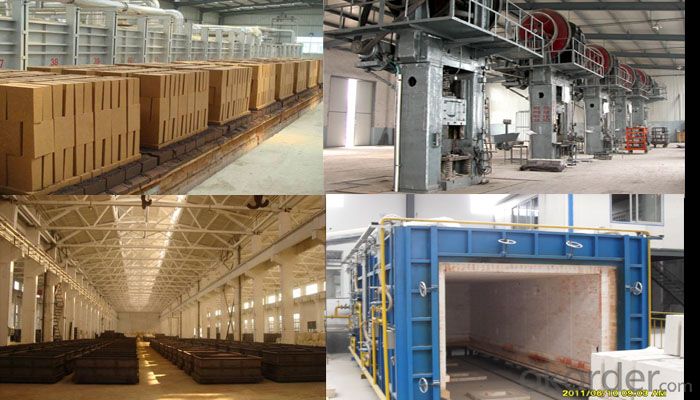
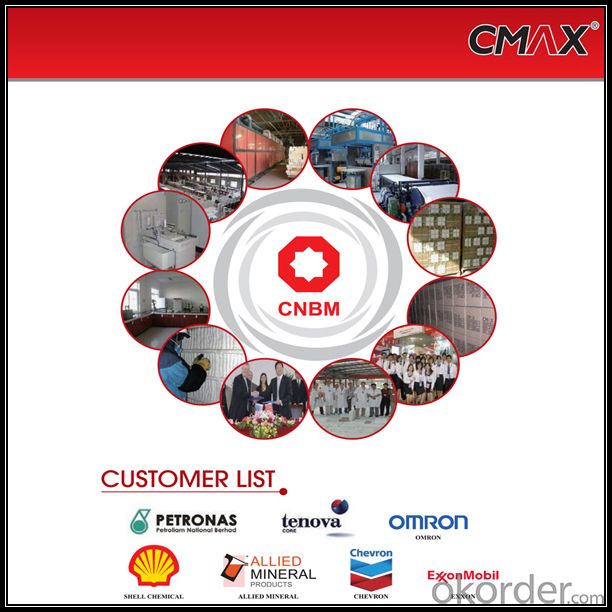
FAQ
1. Which products do you have?
We have all kinds of refractory brick, castable, mortar, cement, ceramic fiber products, etc.
Or you could browse our products to choose what you need.
2. Can you give me a brief introduction of the application of your products?
We are mainly specializing in the refractory materials in iron and steel, cement, glass, ceramics, petrochemical, electric power Industry, etc.
3. If I need your offer, what information do you need?
In order to choose suitable products, it will be appreciated to provide us the information, such us specification, technical data, order quantity, products application etc. If any question, please contact us freely.
- Q: Can insulating fire bricks be used in the construction of smelting ovens?
- Yes, insulating fire bricks can be used in the construction of smelting ovens. Insulating fire bricks are designed to have low thermal conductivity, which means they are excellent at retaining heat. This property makes them ideal for applications where high temperatures need to be maintained, such as smelting ovens. Smelting ovens are used to melt and refine various metals and minerals. These processes involve extremely high temperatures, and it is crucial to minimize heat loss to ensure efficient and effective smelting. Insulating fire bricks can help achieve this goal by providing excellent insulation and reducing heat loss. Insulating fire bricks are made from lightweight materials, such as ceramic fibers or expanded clay, which have high insulating properties. They are capable of withstanding temperatures up to 3000°F (1650°C), making them suitable for the extreme heat generated in smelting ovens. Additionally, insulating fire bricks are resistant to thermal shock, meaning they can withstand rapid temperature changes without cracking or breaking. This is essential in smelting processes, which often involve heating and cooling cycles. Furthermore, insulating fire bricks are easy to work with and can be cut or shaped to fit specific dimensions or designs. This flexibility makes them highly adaptable for constructing smelting ovens of various shapes and sizes. In summary, insulating fire bricks are an excellent choice for the construction of smelting ovens due to their low thermal conductivity, high temperature resistance, thermal shock resistance, and ease of customization. They can help maintain high temperatures, reduce heat loss, and ensure efficient smelting processes.
- Q: Are insulating fire bricks suitable for applications requiring low thermal conductivity?
- Yes, insulating fire bricks are suitable for applications requiring low thermal conductivity. These bricks are designed to have excellent insulation properties, allowing them to effectively minimize heat transfer and maintain low thermal conductivity. They are commonly used in industries such as metallurgy, ceramics, and glass manufacturing, where thermal insulation is crucial for efficient and controlled processes.
- Q: Can insulating fire bricks be used in residential applications, such as fireplaces or ovens?
- Residential applications like fireplaces or ovens can indeed utilize insulating fire bricks. These bricks are specifically designed for enduring high temperatures and providing outstanding thermal insulation. They are crafted from lightweight materials like clay or alumina, which possess low thermal conductivity. This attribute assists in retaining the heat within the fireplace or oven, enhancing efficiency and reducing energy consumption. Moreover, insulating fire bricks exhibit exceptional resilience against thermal shock, enabling them to withstand sudden temperature fluctuations without cracking or breaking. Additionally, these bricks are non-combustible, ensuring they can withstand the intense temperatures produced in fireplaces or ovens without posing a fire hazard. Consequently, insulating fire bricks are a suitable option for residential applications requiring high temperatures and thermal insulation.
- Q: Are insulating fire bricks fire-rated?
- Indeed, insulating fire bricks possess fire-rating. They are purposefully crafted to endure elevated temperatures and furnish superior thermal insulation in diverse applications. Fashioned from a distinct ceramic material with minimal thermal conductivity, these bricks possess the capability to retain heat and impede its transmission to the surroundings. Such attribute endows them with remarkable fire resistance, thereby safeguarding the structures they are employed in. Commonly employed within furnaces, kilns, fireplaces, and other environments characterized by high temperatures, insulating fire bricks play a pivotal role in ensuring fire protection.
- Q: Can insulating fire bricks be used in the construction of radiant tubes?
- Yes, insulating fire bricks can be used in the construction of radiant tubes. Insulating fire bricks are specially designed to provide excellent thermal insulation, making them ideal for applications where heat retention is important. Radiant tubes are used in high-temperature environments, such as furnaces and kilns, where they are exposed to extreme heat. Insulating fire bricks can withstand these high temperatures and help to minimize heat loss, resulting in improved energy efficiency. Additionally, the insulating properties of these bricks can also help to protect the radiant tubes from thermal shock and prolong their lifespan. Overall, using insulating fire bricks in the construction of radiant tubes can enhance their performance and durability.
- Q: Can insulating fire bricks be used in rocket stove designs?
- Yes, insulating fire bricks can be used in rocket stove designs. Insulating fire bricks are specifically designed to withstand high temperatures and provide excellent insulation, making them ideal for rocket stoves which require efficient heat retention. Their lightweight and high insulating properties help to maximize heat transfer and improve the overall performance of the rocket stove.
- Q: Are insulating fire bricks resistant to gas permeability?
- Yes, insulating fire bricks are resistant to gas permeability. These bricks are designed to have low porosity and high density, which helps to prevent the penetration of gases through their structure. They are made from high-quality refractory materials, such as clay or silica, and are manufactured using a special process to ensure minimal pore size and tight packing. This makes them highly effective in containing gases and preventing their leakage. Insulating fire bricks are commonly used in various high-temperature applications, including furnaces, kilns, and industrial boilers, where gas tightness is essential for efficient and safe operations.
- Q: What temperature can insulating fire bricks withstand?
- Insulating fire bricks are capable of withstanding high temperatures, typically ranging from 2,200 to 3,000 degrees Fahrenheit (1,200 to 1,650 degrees Celsius). These bricks are specifically designed to provide excellent thermal insulation and retain their structural integrity even under extreme heat conditions. The ability to withstand such high temperatures makes insulating fire bricks ideal for various applications, including furnaces, kilns, fireplaces, and other high-temperature environments.
- Q: Can insulating fire bricks be used in glass furnaces?
- Glass furnaces can indeed utilize insulating fire bricks. These bricks are specifically engineered with low thermal conductivity, rendering them ideal for high-temperature environments such as glass furnaces. The implementation of these bricks aids in the reduction of heat loss from the furnace, consequently enhancing energy efficiency and decreasing operational expenses. Moreover, they offer superior insulation and aid in maintaining consistent temperatures within the furnace, a vital factor in glass production. Furthermore, insulating fire bricks exhibit excellent resistance to thermal shock and can endure the extreme temperatures and rapid temperature fluctuations that are common in glass furnaces. Overall, integrating insulating fire bricks into glass furnaces can result in enhanced furnace performance, heightened productivity, and energy conservation.
- Q: Can insulating fire bricks be used for insulation in steel mills?
- Insulation in steel mills is possible with the use of insulating fire bricks. These bricks are crafted from lightweight refractory materials that possess exceptional insulating properties and can endure high temperatures. Their purpose is to limit heat transfer and maintain the desired temperature within the furnace or kiln. In the steel mills, these bricks are applicable for insulating the walls, floors, and roofs of the furnaces, ladles, and other equipment. This insulation aids in minimizing heat loss, enhancing energy efficiency, and ensuring consistent and controlled heating processes. Moreover, insulating fire bricks offer thermal stability and safeguard the steel mill equipment against excessive heat, thereby contributing to extended equipment lifespan and reduced maintenance expenses.
Send your message to us
High Temperature Insulating Fire Brick
- Loading Port:
- China main port
- Payment Terms:
- TT OR LC
- Min Order Qty:
- 2 m.t
- Supply Capability:
- 2000 m.t/month
OKorder Service Pledge
OKorder Financial Service
Similar products
Hot products
Hot Searches
Related keywords
